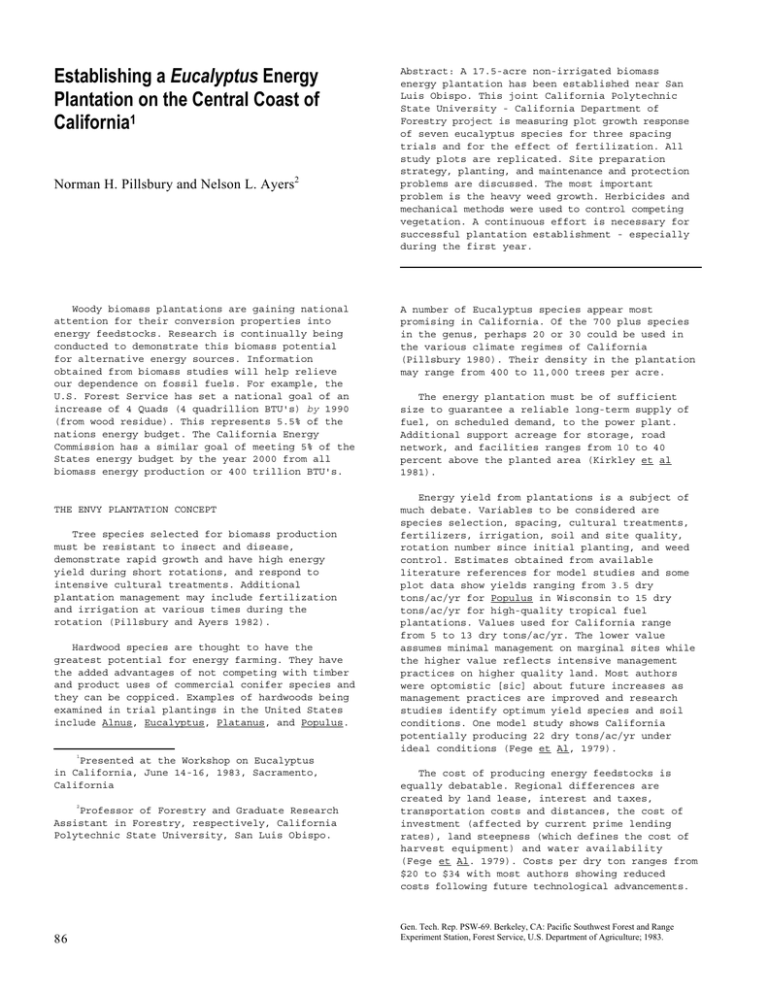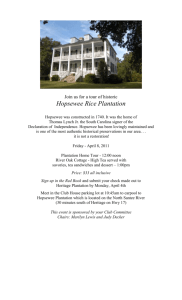Document 11236044
advertisement

Establishing a Eucalyptus Energy Plantation on the Central Coast of California1 Norman H. Pillsbury and Nelson L. Ayers2 Woody biomass plantations are gaining national attention for their conversion properties into energy feedstocks. Research is continually being conducted to demonstrate this biomass potential for alternative energy sources. Information obtained from biomass studies will help relieve our dependence on fossil fuels. For example, the U.S. Forest Service has set a national goal of an increase of 4 Quads (4 quadrillion BTU's) by 1990 (from wood residue). This represents 5.5% of the nations energy budget. The California Energy Commission has a similar goal of meeting 5% of the States energy budget by the year 2000 from all biomass energy production or 400 trillion BTU's. THE ENVY PLANTATION CONCEPT Tree species selected for biomass production must be resistant to insect and disease, demonstrate rapid growth and have high energy yield during short rotations, and respond to intensive cultural treatments. Additional plantation management may include fertilization and irrigation at various times during the rotation (Pillsbury and Ayers 1982). Hardwood species are thought to have the greatest potential for energy farming. They have the added advantages of not competing with timber and product uses of commercial conifer species and they can be coppiced. Examples of hardwoods being examined in trial plantings in the United States include Alnus, Eucalyptus, Platanus, and Populus. Abstract: A 17.5-acre non-irrigated biomass energy plantation has been established near San Luis Obispo. This joint California Polytechnic State University - California Department of Forestry project is measuring plot growth response of seven eucalyptus species for three spacing trials and for the effect of fertilization. All study plots are replicated. Site preparation strategy, planting, and maintenance and protection problems are discussed. The most important problem is the heavy weed growth. Herbicides and mechanical methods were used to control competing vegetation. A continuous effort is necessary for successful plantation establishment - especially during the first year. A number of Eucalyptus species appear most promising in California. Of the 700 plus species in the genus, perhaps 20 or 30 could be used in the various climate regimes of California (Pillsbury 1980). Their density in the plantation may range from 400 to 11,000 trees per acre. The energy plantation must be of sufficient size to guarantee a reliable long-term supply of fuel, on scheduled demand, to the power plant. Additional support acreage for storage, road network, and facilities ranges from 10 to 40 percent above the planted area (Kirkley et al 1981). Energy yield from plantations is a subject of much debate. Variables to be considered are species selection, spacing, cultural treatments, fertilizers, irrigation, soil and site quality, rotation number since initial planting, and weed control. Estimates obtained from available literature references for model studies and some plot data show yields ranging from 3.5 dry tons/ac/yr for Populus in Wisconsin to 15 dry tons/ac/yr for high-quality tropical fuel plantations. Values used for California range from 5 to 13 dry tons/ac/yr. The lower value assumes minimal management on marginal sites while the higher value reflects intensive management practices on higher quality land. Most authors were optomistic [sic] about future increases as management practices are improved and research studies identify optimum yield species and soil conditions. One model study shows California potentially producing 22 dry tons/ac/yr under ideal conditions (Fege et Al, 1979). 1 Presented at the Workshop on Eucalyptus in California, June 14-16, 1983, Sacramento, California 2 Professor of Forestry and Graduate Research Assistant in Forestry, respectively, California Polytechnic State University, San Luis Obispo. 86 The cost of producing energy feedstocks is equally debatable. Regional differences are created by land lease, interest and taxes, transportation costs and distances, the cost of investment (affected by current prime lending rates), land steepness (which defines the cost of harvest equipment) and water availability (Fege et Al. 1979). Costs per dry ton ranges from $20 to $34 with most authors showing reduced costs following future technological advancements. Gen. Tech. Rep. PSW-69. Berkeley, CA: Pacific Southwest Forest and Range Experiment Station, Forest Service, U.S. Department of Agriculture; 1983. No reliable cost estimates were found for marginal lands in California. Cost per million BTU is $1.20 to $2.50 based on 17 million BTU per dry ton, while 1985 costs for coal are projected at $1.50 per million BTU. THE CAL POLY - DEPARTMENT OF FORESTRY EUCALYPTUS ENERGY PLANTATION A joint California Polytechnic State University and California Department of Forestry Eucalyptus Energy Plantation is currently being grown near San Luis Obispo. The plantation is designed to demonstrate the effectiveness of growing non-irrigated eucalyptus trees for biomass energy. The project was initiated in 1979 to evaluate the suitability of several eucalyptus species by measuring mortality and single tree growth rates (Mark et Al. 1980). Results from this initial study were used to select species for a second planting currently being evaluated for growth and yield. The general purpose for this long range biomass study is two-fold. First, the project data will help land owners understand techniques and difficulties involved in establishing a commercial non-irrigated eucalyptus plantation. It will identify management practices and potential problems which influence the success of plantation establishment, maintenance and continued growth. Also, it will provide a source of growth and yield information for energy farmers. Our specific objectives can be best understood by these eight commonly asked questions. 1. 2. 3. 4. 5. What species should be planted? What spacing should be used? What yield can be expected and when? Should the tree be fertilized? What are the requirements for an effective site preparation? 6. How can weed and pest problems be controlled? 7. What is the energy benefit-cost relationship? 8. What rotation age will provide optimum yield? Site Description The study area is located about mid-way (6 miles) between the Pacific Ocean and San Luis Obispo. The planted and support area is 17.5 acres in size and is located on sites typically found along the central coast of California. The elevation is approximately 580 feet and the site is predominantly south-facing with slopes ranging from 5-22 percent. Weather patterns are typically Mediterranean with wet winters and dry summers. The mean annual precipitation in San Luis Obispo for the 1963-1983 period is 27.62 inches; 75 percent occurs from December through March. However, rainfall for 1982-1983 was the third wettest on record, 47.59 inches. The average frost free season exceeds 300 days. The mean annual temperature for the last 20 years was 63.8 degrees Fahrenheit. The soils are classified as Los Osos variant clay loam. The surface layer is grayish brown clay loam about 12 inches deep and the subsoil is pale brown clay about 27 inches thick. The underlying material in the subsoil is moderately alkaline and consists of calcareous clay loam extending to a depth of greater than 60 inches. Several rock-outcroppings are located on the site. Grass species such as wild oats (Avena fatua L.), annual rye grass (Lolium multiflorum Lam.), and soft chess (Bromus mollis L.) are prevalent. The land was previously used for cattle grazing. Site Preparation The study area was burned in October 1982 to eliminate all weeds and competing vegetation. A single shank was used to rip each row to an approximate depth of 2.5 feet. The site received 2 inches of precipitation prior to cross discing. The purpose of cross discing was to close the gap and seal the moisture into the ground. Planting was delayed several weeks due to high soil moisture conditions; excessive weed growth occurred during that period. To eliminate weed growth prior to planting Round-up, a non-selective post-emergent herbicide, was applied. The rate of application was 4.5 ounces of active ingredient in 2.5 gallons of water per acre. Simazine which is a pre-emergent herbicide will be applied shortly before the first Fall rains to prohibit annual weed emergence. It will be applied at a rate of 4 pounds of active ingredient in 25 gallons of water per acre. Plantation Design The Eucalyptus plantation consists of a split plot randomized block design for seven species. Each species is being tested for its response to a fertilizer treatment and for three spacings of 3 x 12 feet, 6 x 12 feet and 9 x 12 feet. The spacing between rows for all plots is 12 feet to accommodate farm machinery sizes normally available for planting, maintenance, and harvesting. Control plots (non-fertilized) were also established for these spacings as shown in figure 1. Each spacing trial contains 6 rows with 6 trees per row or 36 trees. The treatment and control plots contain 108 trees each (36 trees x 3 spacings) or 216 trees per species. Each species was replicated to complete the randomized block design shown in figure 1. The data collected from these plots will be used for yield analysis. Several buffer rows were planted adjacent to the plots to protect yield trees from external influences. These buffer trees will not be used in the evaluation of plantation yield. 87 Species Selection And Seed Source The seven species to be evaluated are; 1. Eucalyptus camaldulensis (Dehnh. var. camaldulensis) 2. Eucalyptus citriodora (Hook f.) 3. Eucalyptus dalrympleana (Maid. subsp. dalrympleana) 4. Eucalyptus globulus (Labill. subsp. globulus) 5. Eucalyptus grandis (Hill ex Maid.) 6. Eucalyptus sideroxylon (A. Cum. ex, Woolls subsp. sideroxylon) 7. Eucalyptus viminalis (Labill.) 88 E. dalrympleana, E. grandis, and E. sideroxylon were selected for the study because they have demonstrated excellent potential for biomass production in other regions in California (Mariani jet A1. 1978 and Sachs et al. 1980). The other species demonstrated rapid growth, ease in regeneration and establishment, tolerance to insects and pathogens, and their suitability to the soil and environmental conditions of the central coast area in a previous study. All species were closely matched to the temperature and precipitation patterns for San Luis Obispo County. The seed source for all species except E. citriodora originated in Australia. They were propagated in 1 by 6 inch squared plastic containers having a medium of 90 percent peat moss-vermiculite and 10 percent perlite. The California Department of Forestry Nursery at Davis cultivated the seedlings in their greenhouse- nursery complex where seasonal moisture and temperature conditions were simulated. The eucalyptus seedlings were 1 year old at the time of planting. The E. citriodora was purchased from a private commercial nursery and no information was available to describe its origin and propagation history. They were approximately 3 months old when planted. The data will be used to compare productivity by species and spacing and to test the effect of fertilization. Project Timetable In addition to information about site preparation techniques discussed earlier, more information will be available on mortality, weed control, deer browsing and plantation establishment problems by summer 1984. By 1989 the remaining questions relating to yield, energy benefit-cost ratio, optimum spacing, and best rotation age can be more fully answered. Planting and Maintenance Problems The Eucalyptus Energy Plantation was planted during a 2 week period in mid-February 1983. Trees in fertilized plots were given a 21 gram slow-release Agri-form fertilizer tablet containing 20 percent nitrogen, 10 percent phosphoric acid and 5 percent soluble potash. The pellet was placed about 3 inches below the root zone (1 foot from the soil surface) during planting. During the initial 4 month growing period the plantation became heavily infested by weeds. However, only sparse weed coverage occurred along the rows compared to the inter-row area. It appears that ripping, in this case to a depth of 2.5 feet, in addition to breaking up any hard pan soil layers to provide for better root penetration, also provides a form of weed control. A preliminary investigation shows that the majority of seedling mortality on the plantation occurred in E. citriodora where over 95 percent died. This exceptionally high rate may be due to age of the delivered stock (3 months) or to improper "hardening" practices. It is recommended that all species be the same age for comparing growth rates. Deer browsing was prevalent throughout the plantation although most of the damage was located in one area. Species that were browsed include; E. viminalis, E. camaldulensis, E. grandis, E. dalrympleana and E. sideroxylon. Continued deer browse caused the seedlings to develop extensive lateral branching. This may require pruning to maintain the desired tree form. Several perches will be located throughout the plantation. By attracting predators, it is anticipated that the rodent population will be controlled. Productivity Measurements Plot productivity measurements will include height and diameter beginning in the first year. A correlation between height, diameter, weight, and energy yield will start the second year; by the third year sprouts will be evaluated. ACKNOWLEDGMENTS Acknowledgments: We thank Gary Brittner, California Department of Forestry, Sacramento; David Soho, California Department of Forestry, Monterey; and the California Conservation Corps, San Luis Obispo for their project and manpower support. This study is supported by Grant 3-080-019, California Department of Forestry. REFERENCES Fege, A.S., Inman, R.E. and D.J. Salo. Energy farms for the future. J. Forestry. June 1979. Kirkley, M.L., Pillsbury, N.H., and Walter Mark. Silvicultural biomass plantation: A renewable fuel source. Proceedings of the Symposium on Dynamics and Management of Mediterranean-type Ecosystems, June 22-26, 1981, San Diego, Calif. U.S. For. Serv., Pacific Southwest For. and Rge. Exp. Sta., PSW-58. pp 1107-1109. Mariani, E.O., Wood, W.A., Kouchoukos, P.C. and M.B. Minton. The eucalyptus energy farm feasi­ bility study and demonstration. Phase I: site and species selection. Marelco, Inc. 1978. Mark, W.R., Pillsbury, N.H. and M. Kirkley. Silvicultural energy plantation establishment, Cal Poly, San Luis Obispo. 1980. Progress Report. Wood Energy Program, Calif. Dept. of Forestry, Sacramento. 36 p. Pillsbury, N.H. A summary of the potential and problems of silvicultural energy plantations in California. Presented at the July, 1980 Calif. Energy Comm. Biomass/Synfuels Workshop, Sacramento. Pillsbury, N.H. and N.L. Ayers. The potential and design for California's energy plantations. Presented at Soc. of American Foresters Wood Energy Conference, January 30, 1982, Riverside. Sachs, R.M., Gilpin D.W., and T. Mock. Yields of short rotation Eucalyptus grandis in high density plantings. Proceedings, Energy from Biomass and Wastes, January 21-25, 1980. Lake Buena Vista, FL. 89






